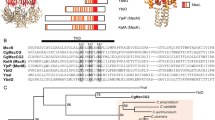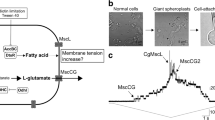Abstract
The spider peptide GsMTx4, at saturating concentration of 5 μM, is an effective and specific inhibitor for stretch-activated mechanosensitive (MS) channels found in a variety of eukaryotic cells. Although the structure of the peptide has been solved, the mode of action remains to be determined. Because of its amphipathic structure, the peptide is proposed to interact with lipids at the boundaries of the MS channel proteins. In addition, GsMTx4 has antimicrobial effects, inhibiting growth of several species of bacteria in the range of 5–64 μM. Previous studies on prokaryotic MS channels, which serve as model systems to explore the principle of MS channel gating, have shown that various amphipathic compounds acting at the protein–lipid interface affect MS channel gating. We have therefore analyzed the effect of different concentrations of extracellular GsMTx4 on MS channels of small conductance, MscS and MscK, in the cytoplasmic membrane of wild-type E. coli spheroplasts using the patch-clamp technique. Our study shows that the peptide GsMTx4 exhibits a biphasic response in which peptide concentration determines inhibition or potentiation of activity in prokaryotic MS channels. At low peptide concentrations of 2 and 4 μM the gating of the prokaryotic MS channels was hampered, manifested by a decrease in pressure sensitivity. In contrast, application of peptide at concentrations of 12 and 20 μM facilitated prokaryotic MS channel opening by increasing the pressure sensitivity.




Similar content being viewed by others
Abbreviations
- MS:
-
Mechanosensitive channels
- WT:
-
Wild-type
- SACs:
-
Stretch-activated channels
- MscL:
-
Mechanosensitive channel of large conductance
- MscS:
-
Small conductance
- MscK:
-
Small conductance, K+ dependent
- MscM:
-
Mini-conductance
- POPG:
-
Palmitoyloleoylphosphoglycerol
- POPC:
-
Palmitoyloleoylphosphocholine
- PE:
-
Phosphoethanolamine
- PG:
-
Phosphoglycerol
- PC:
-
Pressure cycle
References
Akitake B, Anishkin A, Sukharev S (2005) The “dashpot” mechanism of stretch-dependent gating in MscS. J Gen Physiol 125:143–154. doi:10.1085/jgp.200409198
Berrier C, Besnard M, Ajouz B, Coulombe A, Ghazi A (1996) Multiple mechanosensitive ion channels from Escherichia coli, activated at different thresholds of applied pressure. J Membr Biol 151:175–187. doi:10.1007/s002329900068
Bode F, Sachs F, Franz MR (2001) Tarantula peptide inhibits atrial fibrillation. Nature 409:35
Bowman CL, Gottlieb PA, Suchyna TM, Murphy YM, Sachs F (2007) Mechanosensitive ion channels and the peptide inhibitor GsMTx-4: history, properties, mechanisms and pharmacology. Toxicon 49:249–270. doi:10.1016/j.toxicon.2006.09.030
Chemin J, Patel AJ, Duprat F, Sachs F, Lazdunski M, Honore E (2007) Up- and down-regulation of the mechano-gated K(2P) channel TREK-1 by PIP (2) and other membrane phospholipids. Pflugers Arch Eur J Physiol 455:97–103
Cui C, Smith DO, Adler UJ (1995) Characterization of mechanosensitive channels in Escherichia coli cytoplasmic membranes by whole cell patch clamp recording. J Membr Biol 144:31–42. doi:10.1007/BF00238414
Ermakov YA, Averbakh AZ, Arbuzova AB, Sukharev SI (1998) Dipole potentials indicate restructuring of the membrane interface induced by gadolinium and beryllium ions. Membr Cell Biol 12:411–426
Gottlieb PA, Suchyna TM, Sachs F (2007) Properties and mechanism of the mechanosensitive ion channel inhibitor GsMTx4, a therapeutic peptide derived from tarantula venom. Curr Top Membr 59:81–109. doi:10.1016/S1063-5823(06)59004-0
Gustin MC, Zhou XL, Martinac B, Kung C (1988) A mechanosensitive ion channel in the yeast plasma membrane. Science 242:762–765
Hamill OP, Martinac B (2001) Molecular basis of mechanotransduction in living cells. Physiol Rev 81:685–740
Hamill OP, McBride DW Jr (1996) The pharmacology of mechanogated membrane ion channels. Pharmacol Rev 48:231–252
Heller DN, Cotter RJ, Fenselau C (1987) Profiling of bacteria by fast atom bombardment mass spectroscopy. Anal Chem 59:2806–2809. doi:10.1021/ac00150a018
Howard J, Roberts WM, Hudspeth AJ (1988) Mechanoelectrical transduction by hair cells. Annu Rev Biophys Chem 17:99–124
Jung HJ, Kim P, Lee SK, Lee CW, Eu Y-J, Lee DG, Earm Y-E, Kim JI (2006) Lipid membrane interaction and antimicrobial activity of GsMTx-4, an inhibitor of mechanosensitive channel. Biochem Biophys Res Commun 340:633–638. doi:10.1016/j.bbrc.2005.12.046
Kloda A, Martinac B (2002) Common evolutionary origins of mechanosensitive ion channels in archaea, bacteria and cell-walled Eukarya. Archaea 1:35–44
Kung C (2005) A possible unifying principle for mechanosensation. Nature 436:647–654. doi:10.1038/nature03896
Levina N, Totemeyer S, Stokes NR, Louis P, Jones MA, Booth IR (1999) Protection of Escherichia coli cells against extreme turgor by activation of MscS and MscL mechanosensitive channels: identification of genes required for MscS activity. EMBO J 18:1730–1737. doi:10.1093/emboj/18.7.1730
Li Y, Moe PC, Chandrasekaran S, Booth ER, Blount P (2002) Ionic regulation of MscK, a mechanosensitive channel from Escherichia coli. EMBO J 12:5323–5330. doi:10.1093/emboj/cdf537
Lin JH, Rydqvist B (1999) The mechanotransduction of the crayfish stretch receptor neuron can be differentially activated or inactivated by local anaesthetics. Acta Physiol Scand 166:65–74. doi:10.1046/j.1365-201X.1999.00525.x
Martinac B (2004) Mechanosenitive ion channels: molecules of mechanotransduction. J Cell Sci 117:2449–2460. doi:10.1242/jcs.01232
Martinac B, Buechner M, Delcour AH, Adler J, Kung C (1987) Pressure-sensitive ion channel in Escherichia coli. Proc Natl Acad Sci USA 84:2297–2301. doi:10.1073/pnas.84.8.2297
Martinac B, Adler J, Kung C (1990) Mechanosensitive ion channels of E. coli activated by amphipaths. Nature 348:261–263. doi:10.1038/348261a0
Nishizawa M, Nishizawa K (2007) Molecular dynamics simulations of a stretch-activated channel inhibitor GsMTx4 with lipid membranes: two binding modes and effects of lipid structure. Biophys J 92:4233–4243. doi:10.1529/biophysj.106.101071
Ostrow KL, Mammoser A, Suchyna T, Sachs F, Oswald R, Kubo S, Chino N, Gottlieb PA (2003) cDNA sequence and in vitro folding of GsMTx4, a specific peptide inhibitor of mechanosensitive channels. Toxicon 42:263–274
Oswald RE, Suchyna TM, McFeeters R, Gottlieb PA, Sachs F (2002) Solution structure of peptide toxins that block mechanosensitive ion channels. JBC 277:34443
Patel AJ, Lazdunski M, Honoré E (2001) Lipid and mechano-gated 2P domain K(+) channels. Curr Opin Cell Biol 13:422–428. doi:10.1016/S0955-0674(00)00231-3
Perozo E (2006) Gating prokaryotic mechanosensitive channels. Nat Rev Mol Cell Biol 7:109–119. doi:10.1038/nrm1833
Perozo E, Kloda A, Cortes DM, Martinac B (2002) Physical principles underlying the transduction of bilayer deformation forces during mechanosensitive channel gating. Nat Struct Mol Biol 9:696–703. doi:10.1038/nsb827
Phillips LR, Milescu M, Li-Smerin Y, Mindell JA, Kim JI, Swartz KJ (2005) Voltage-sensor activation with a tarantula toxin as cargo. Nature 436:857–860. doi:10.1038/nature03873
Posokhov YO, Gottlieb PA, Morales MJ, Sachs F, Ladokhin AS (2007) Is lipid bilayer binding a common property of inhibitor cysteine knot ion-channel blockers? Biophys J 93:L20–L22. doi:10.1529/biophysj.107.112375
Qi Z, Chi S, Naruse K, Sokabe M (2005) Activation of a mechanosensitive BK channel by membrane stress created with amphipaths. Mol Membr Biol 22:519–527. doi:10.1080/09687860500370703
Sachs F, Sokabe M (1990) Stretch-activated ion channels and membrane mechanics. Neurosci Res Suppl 12:S1–S4
Sokabe M, Sachs F, Jing ZQ (1991) Quantitative video microscopy of patch clamped membranes stress, strain, capacitance, and stretch channel activation. Biophys J 59:722–728
Sotomayor M, Vasquez V, Perozo E, Schulten K (2007) Ion conduction through MscS as determined by electrophysiology and simulation. Biophys J 92:886–902. doi:10.1529/biophysj.106.095232
Suchyna TM, Johnson JH, Hamer K, Leykam JF, Gage DA, Clemo HF, Baumgarten CM, Sachs F (2000) Identification of a peptide toxin from Grammostola spatulata spider venom that blocks cation-selective stretch-activated channels. J Gen Physiol 115:583–598. doi:10.1085/jgp.115.5.583
Suchyna TM, Tape SE, Koeppe RE, Andersen OS, Sachs F, Gottlieb PA (2004) Bilayer-dependent inhibition of mechanosensitive channels by neuroactive peptide enantiomers. Nature 430:235–240. doi:10.1038/nature02743
Vasquez V, Marien Cortes D, Furukawa H, Perozo E (2007) An optimized purification and reconstitution method for the MscS channel: strategies for spectroscopical analysis. Biochemistry 46:6766–6773. doi:10.1021/bi700322k
Wikström M, Xie J, Bogdanov M, Mileykovskaya E, Heacock P, Wieslander Å, Dowhan W (2004) Monoglucosyldiacylglycerol, a foreign lipid, can substitute for phosphatidylethanolamine in essential membrane-associated functions in Escherichia coli. J Biol Chem 279:10484–10493. doi:10.1074/jbc.M310183200
Zhang Y, Hamill OP (2000) On the discrepancy between whole-cell and membrane patch mechanosensitivity in Xenopus oocytes. J Physiol 15:101–115
Zhu S, Darbon H, Dyason K, Verdonck F, Tytgat J (2003) Evolutionary origin of inhibitor cystine knot peptides. FASEB J 17:1765–1767
Acknowledgments
We are grateful to Dr. Frederick Sachs for critical reading of the manuscript and constructive comments. Dr. Åke Wieslander and Dr. Daniel Daley are thanked for sharing important information on their lipid mutant E. coli strains. We like to thank Paul Rohde for technical assistance. The work was supported by a grant from the National Health and Medical Research Council to B.M.
Author information
Authors and Affiliations
Corresponding author
Rights and permissions
About this article
Cite this article
Hurst, A.C., Gottlieb, P.A. & Martinac, B. Concentration dependent effect of GsMTx4 on mechanosensitive channels of small conductance in E. coli spheroplasts. Eur Biophys J 38, 415–425 (2009). https://doi.org/10.1007/s00249-008-0386-9
Received:
Revised:
Accepted:
Published:
Issue Date:
DOI: https://doi.org/10.1007/s00249-008-0386-9




